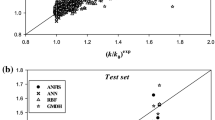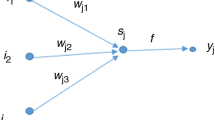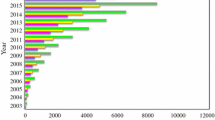Abstract
Nanofluids are kind of fluids, which have a wide range of applications in different fields such as industry or engineering systems. The present study efforts to find accurate relationships between the convective heat transfer coefficient of the nanofluids containing the silica nanoparticles as a function of Reynolds number, Prandtl number, and mass fraction nanofluid. To that end, a number of seven different models including adaptive neuro-fuzzy inference system (ANFIS), artificial neural network (ANN), support vector machine (SVM), least square support vector machine (LSSVM), genetic programming (GP), principal component analysis (PCA), and committee machine intelligent system (CMIS) have been implemented according to experimental databases designed for measuring the convective heat transfer coefficient of nanofluid in circular cross-sectional channels. Results indicated the satisfactory capability of suggested models, especially CMIS model in order to estimate the convective heat transfer coefficient of nanofluid. The obtained statistical analyses such as the mean square error and R-squared (R 2) for the ANFIS, ANN, SVM, LSSVM, PCA, GP, and CMIS were 380.6671 and 0.9946, 215.062 and 0.9969, 335.748 and 0.9951, 298.88 and 0.9959, 1601.336 and 0.977, 1891.861 and 0.973, and 205.366 and 0.9970 correspondingly. We expect that these suggested models can help engineers who deal with heat transfer phenomenon to have great predictive tools for estimating convective heat transfer coefficient of nanofluid.




























Similar content being viewed by others
References
Khanjari Y, Pourfayaz F, Kasaeian A. Numerical investigation on using of nanofluid in a water-cooled photovoltaic thermal system. Energy Convers Manag. 2016;122:263–78.
Amin TE, Roghayeh G, Fatemeh R, Fatollah P. Evaluation of nanoparticle shape effect on a nanofluid based flat-plate solar collector efficiency. Energy Explor Exploit. 2015;33(5):659–76.
Lee S, Choi S-S, Li S, Eastman J. Measuring thermal conductivity of fluids containing oxide nanoparticles. J Heat Transfer. 1999;121(2):280–9.
Das SK, Putra N, Thiesen P, Roetzel W. Temperature dependence of thermal conductivity enhancement for nanofluids. J Heat Transfer. 2003;125(4):567–74.
Masuda H, Ebata A, Teramae K. Alteration of thermal conductivity and viscosity of liquid by dispersing ultra-fine particles: dispersion of Al2O3, SiO2 and TiO2 ultra-fine particles. Netsu Bussei. 1993;7(4):227–33.
Oh D-W, Jain A, Eaton JK, Goodson KE, Lee JS. Thermal conductivity measurement and sedimentation detection of aluminum oxide nanofluids by using the 3ω method. Int J Heat Fluid Flow. 2008;29(5):1456–61.
Hung T-C, Yan W-M, Wang X-D, Chang C-Y. Heat transfer enhancement in microchannel heat sinks using nanofluids. Int J Heat Mass Transf. 2012;55(9):2559–70.
Öztop HF, Estellé P, Yan W-M, Al-Salem K, Orfi J, Mahian O. A brief review of natural convection in enclosures under localized heating with and without nanofluids. Int Commun Heat Mass Transfer. 2015;60:37–44.
Nasiri M, Etemad SG, Bagheri R. Experimental heat transfer of nanofluid through an annular duct. Int Commun Heat Mass Transfer. 2011;38(7):958–63.
Nasrin R, Alim M. Semi-empirical relation for forced convective analysis through a solar collector. Sol Energy. 2014;105:455–67.
Sahin B, Gültekin GG, Manay E, Karagoz S. Experimental investigation of heat transfer and pressure drop characteristics of Al2O3–water nanofluid. Exp Thermal Fluid Sci. 2013;50:21–8.
Saeedinia M, Akhavan-Behabadi M, Nasr M. Experimental study on heat transfer and pressure drop of nanofluid flow in a horizontal coiled wire inserted tube under constant heat flux. Exp Thermal Fluid Sci. 2012;36:158–68.
Moghadassi A, Masoud Hosseini S, Henneke D, Elkamel A. A model of nanofluids effective thermal conductivity based on dimensionless groups. J Therm Anal Calorim. 2009;96(1):81–4.
Barbés B, Páramo R, Blanco E, Pastoriza-Gallego MJ, Pineiro MM, Legido JL, et al. Thermal conductivity and specific heat capacity measurements of Al2O3 nanofluids. J Therm Anal Calorim. 2013;111(2):1615–25.
Huminic G, Huminic A. Application of nanofluids in heat exchangers: a review. Renew Sustain Energy Rev. 2012;16(8):5625–38.
Sarkar J. A critical review on convective heat transfer correlations of nanofluids. Renew Sustain Energy Rev. 2011;15(6):3271–7.
Vajjha RS, Das DK, Kulkarni DP. Development of new correlations for convective heat transfer and friction factor in turbulent regime for nanofluids. Int J Heat Mass Transf. 2010;53(21):4607–18.
Lu G, Wang X-D, Duan Y-Y. A critical review of dynamic wetting by complex fluids: from Newtonian fluids to non-Newtonian fluids and nanofluids. Adv Coll Interface Sci. 2016;236:43–62.
Lu G, Duan Y-Y, Wang X-D. Surface tension, viscosity, and rheology of water-based nanofluids: a microscopic interpretation on the molecular level. J Nanopart Res. 2014;16(9):2564.
Yang L, Du K, Zhang X. A theoretical investigation of thermal conductivity of nanofluids with particles in cylindrical shape by anisotropy analysis. Powder Technol. 2017;314:328–338.
Valinataj-Bahnemiri P, Ramiar A, Manavi S, Mozaffari A. Heat transfer optimization of two phase modeling of nanofluid in a sinusoidal wavy channel using Artificial Bee Colony technique. Eng Sci Technol Int J. 2015;18(4):727–37.
Islam M, Shabani B, Rosengarten G, Andrews J. The potential of using nanofluids in PEM fuel cell cooling systems: a review. Renew Sustain Energy Rev. 2015;48:523–39.
Baghban A, Ahmadi MA, Pouladi B, Amanna B. Phase equilibrium modeling of semi-clathrate hydrates of seven commonly gases in the presence of TBAB ionic liquid promoter based on a low parameter connectionist technique. J Supercrit Fluids. 2015;101:184–92.
Baghban A, Ahmadi MA, Shahraki BH. Prediction carbon dioxide solubility in presence of various ionic liquids using computational intelligence approaches. J Supercrit Fluids. 2015;98:50–64.
Baghban A, Bahadori M, Rozyn J, Lee M, Abbas A, Bahadori A, et al. Estimation of air dew point temperature using computational intelligence schemes. Appl Therm Eng. 2016;93:1043–52.
Mohanraj M, Jayaraj S, Muraleedharan C. Applications of artificial neural networks for refrigeration, air-conditioning and heat pump systems—a review. Renew Sustain Energy Rev. 2012;16(2):1340–58.
Kurt H, Kayfeci M. Prediction of thermal conductivity of ethylene glycol–water solutions by using artificial neural networks. Appl Energy. 2009;86(10):2244–8.
Durairaj M, Thamilselvan P. Applications of artificial neural network for IVF data analysis and prediction. J Eng Comput Appl Sci (JEC and AS). 2013;2(9):11–5.
Kalogirou SA. Applications of artificial neural-networks for energy systems. Appl Energy. 2000;67(1):17–35.
Bhoopal RS, Sharma P, Singh R, Beniwal R. Applicability of artificial neural networks to predict effective thermal conductivity of highly porous metal foams. J Porous Media. 2013;7:585–96.
Jang J-S, Sun C-T. Neuro-fuzzy modeling and control. Proc IEEE. 1995;83(3):378–406.
Jang J-SR, Sun C-T. Neuro-fuzzy and soft computing: a computational approach to learning and machine intelligence. Upper Saddle River: Prentice-Hall Inc; 1996.
Buragohain M, Mahanta C. A novel approach for ANFIS modelling based on full factorial design. Appl Soft Comput. 2008;8(1):609–25.
Ying L-C, Pan M-C. Using adaptive network based fuzzy inference system to forecast regional electricity loads. Energy Convers Manag. 2008;49(2):205–11.
Ozturk A, Arslan A, Hardalac F. Comparison of neuro-fuzzy systems for classification of transcranial Doppler signals with their chaotic invariant measures. Expert Syst Appl. 2008;34(2):1044–55.
Wang S-C. Artificial neural network. Interdisciplinary computing in java programming. Berlin: Springer; 2003. p. 81–100.
Hagan MT, Demuth HB, Beale MH. Neural network design. Boston: PWS Publisher; 1996.
Harrington PdB. Sigmoid transfer functions in backpropagation neural networks. Anal Chem. 1993;65(15):2167–8.
Buntine WL, Weigend AS. Bayesian back-propagation. Complex Syst. 1991;5(6):603–43.
Chauvin Y, Rumelhart DE. Backpropagation: theory, architectures, and applications. Hove: Psychology Press; 1995.
Suykens JA, Vandewalle J. Least squares support vector machine classifiers. Neural Process Lett. 1999;9(3):293–300.
Steinwart I, Christmann A. Support vector machines. Berlin: Springer; 2008.
Suykens JA, Vandewalle J. Recurrent least squares support vector machines. IEEE Trans Circuits Syst I Fundam Theory Appl. 2000;47(7):1109–14.
Bair E, Hastie T, Paul D, Tibshirani R. Prediction by supervised principal components. J Am Stat Assoc. 2006;101(473):119–137.
Björck Ȧ, Pereyra V. Solution of Vandermonde systems of equations. Math Comput. 1970;24(112):893–903.
Macon N, Spitzbart A. Inverses of Vandermonde matrices. Am Math Mon. 1958;65(2):95–100.
Banzhaf W, Nordin P, Keller RE, Francone FD. Genetic programming: an introduction. San Francisco: Morgan Kaufmann Publishers; 1998.
Poli R, Koza J. Genetic programming. Search methodologies. Berlin: Springer; 2014. p. 143–85.
Nilsson NJ. Learning machines: foundations of trainable pattern-classifying systems. New York City: McGraw-Hill; 1965.
Can M. Committee machine networks to diagnose cardiovascular diseases. SouthEast Eur J Soft Comput. 2013;2(1):76-83.
Genest C, Zidek JV. Combining probability distributions: a critique and an annotated bibliography. Stat Sci. 1986;1(1):114–135.
Xu L, Krzyzak A, Suen CY. Methods of combining multiple classifiers and their applications to handwriting recognition. IEEE Trans Syst Man Cybern. 1992;22(3):418–35.
Hashem S, Schmeiser B. Approximating a function and its derivatives using MSE-optimal linear combinations of trained feedforward neural networks. CiteseerX. 1993.
Pourfayaz F, Sanjarian N, Kasaeian A, Razi Astaraie F, Sameti M, Nasirivatan S. An experimental comparison of SiO2/water nanofluid heat transfer in square and circular cross-section channels. J Therm Anal Calorim. 2017. https://doi.org/10.1007/s10973-017-6500-4.
Levenberg K. A method for the solution of certain non-linear problems in least squares. Quart Appl Math. 1944;2:164–8.
Marquardt DW. An algorithm for least-squares estimation of nonlinear parameters. J Soc Ind Appl Math. 1963;11(2):431–41.
Rousseeuw PJ, Leroy AM. Robust regression and outlier detection. Hoboken: Wiley; 2005.
Hosseinzadeh M, Hemmati-Sarapardeh A. Toward a predictive model for estimating viscosity of ternary mixtures containing ionic liquids. J Mol Liq. 2014;200:340–8.
Mohammadi AH, Gharagheizi F, Eslamimanesh A, Richon D. Evaluation of experimental data for wax and diamondoids solubility in gaseous systems. Chem Eng Sci. 2012;81:1–7.
Acknowledgements
The authors would like to thank the reviewers for their valuable comments, which have been utilized in improving the quality of the paper.
Author information
Authors and Affiliations
Corresponding authors
Ethics declarations
Conflict of interest
The authors declare that they have no conflict of interests.
Rights and permissions
About this article
Cite this article
Baghban, A., Pourfayaz, F., Ahmadi, M.H. et al. Connectionist intelligent model estimates of convective heat transfer coefficient of nanofluids in circular cross-sectional channels. J Therm Anal Calorim 132, 1213–1239 (2018). https://doi.org/10.1007/s10973-017-6886-z
Received:
Accepted:
Published:
Issue Date:
DOI: https://doi.org/10.1007/s10973-017-6886-z




